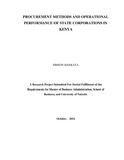| dc.description.abstract | Procurement methods strive to achieve multiple interests and objectives while at the same
time enhancing operational performance. Procurement has an overall objective of
minimizing inventory levels held while at the same time meeting the needs of the firm.
Operational performance on the other hand aims at making inventory readily available to
improve firm`s operational performance. Firms embrace procurement methods that
enhance efficiency and operational performance with the overall aim of getting the most
value for money. In the recent past, there has been growing focus on the operational
performance of state corporations. State corporations are increasingly faced with the
challenge to do things efficiently but with fewer resources while at the same time
improving service delivery to the citizens. There is increasing need for State Corporations
to devote more resources to the delivery of services and streamline their operational
performance. In pursuing these objectives, state corporations are faced with enormous
operational challenges. The most common challenges include inefficiencies in their
operations, huge losses, budgetary burdens and provision of poor services to the
citizenry. This study sought to establish procurement methods used by state corporations
in Kenya and ascertain if there was a functional relationship between the procurement
methods and operational performance of the state corporations in Kenya. The research
study involved a descriptive research design of cross sectional type where a sample of
state corporations was selected across the ten sectors of the economy in Kenya. A total of
32 state corporations were selected for the study, each organization selected was given
one questionnaire with targeted questions aimed at meeting the objectives of the study.
To enhance consistency in the results, a standard questionnaire was developed with open
ended questions addressing the twin objectives of the study. Quantitative data collected
was analyzed by use of descriptive statistics to generate percentages, means, standard
deviations and frequencies. This was done by tallying up responses, computing
percentages of variations in response as well as describing and interpreting the data in
line with the study objectives and assumptions. Tables and other graphical presentations
as appropriate were used to present the data collected for ease of understanding and
analysis. Data was also analyzed using Statistical Package for Social Scientists (SPSS). A
regression was done and the results obtained interpreted. The study established that the
procurement methods used by state corporations to a large extent are price based and
hence may not necessarily guarantee the best value for money. Best value procurement
methods such as negotiated procurement were used but to a small extent. Subjective and
qualitative procurement methods such as specialized task, community participation and
Force account were least used by the state corporations in Kenya and most of these were
unknown by the state corporations.
The study concluded that there is a relationship between the procurement methods and
operational performance of state corporations. The relationship varied between procuring
for services, works and goods. With the impact on efficiency in procuring of services
being greater that works and goods. | en_US |

